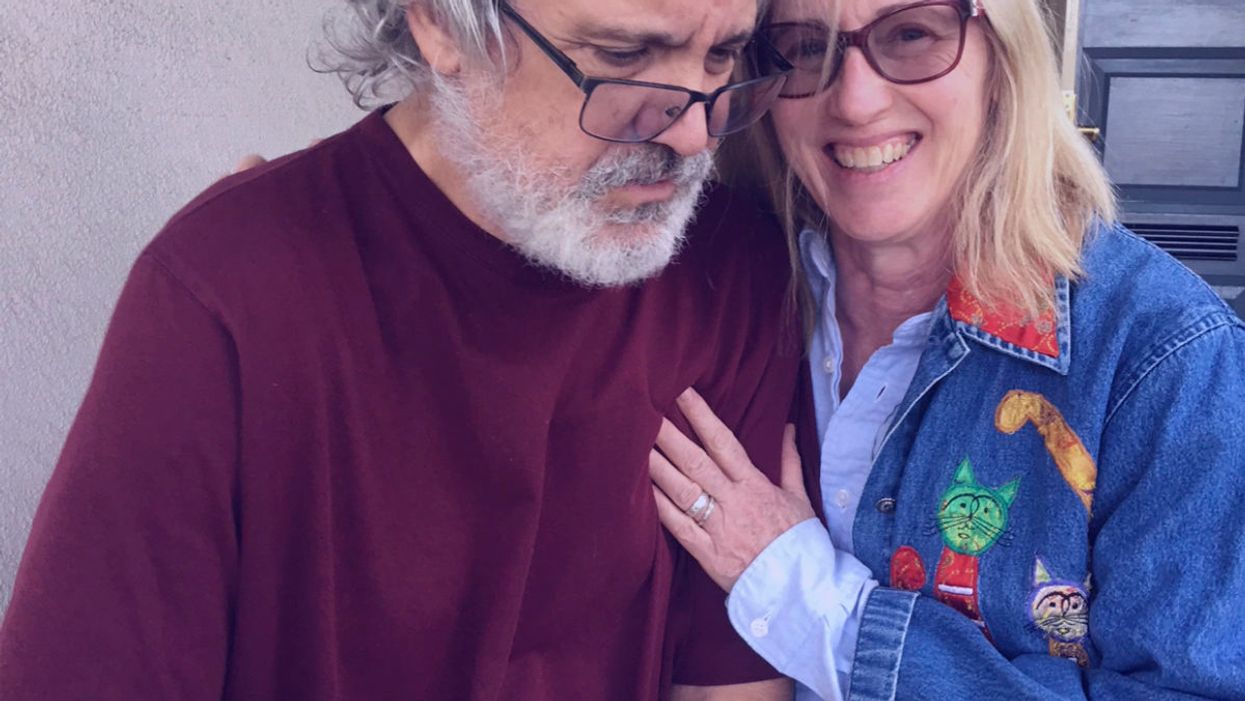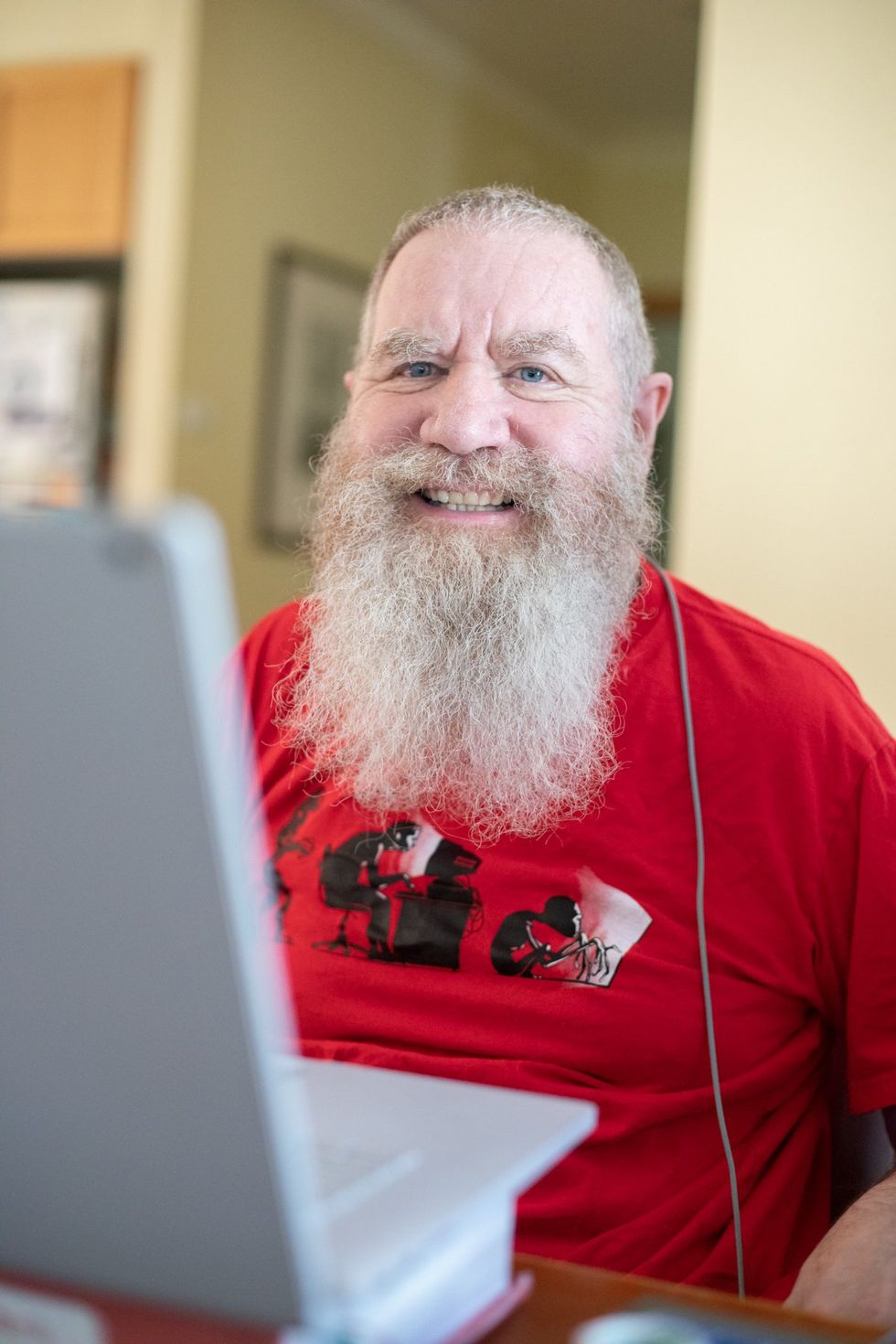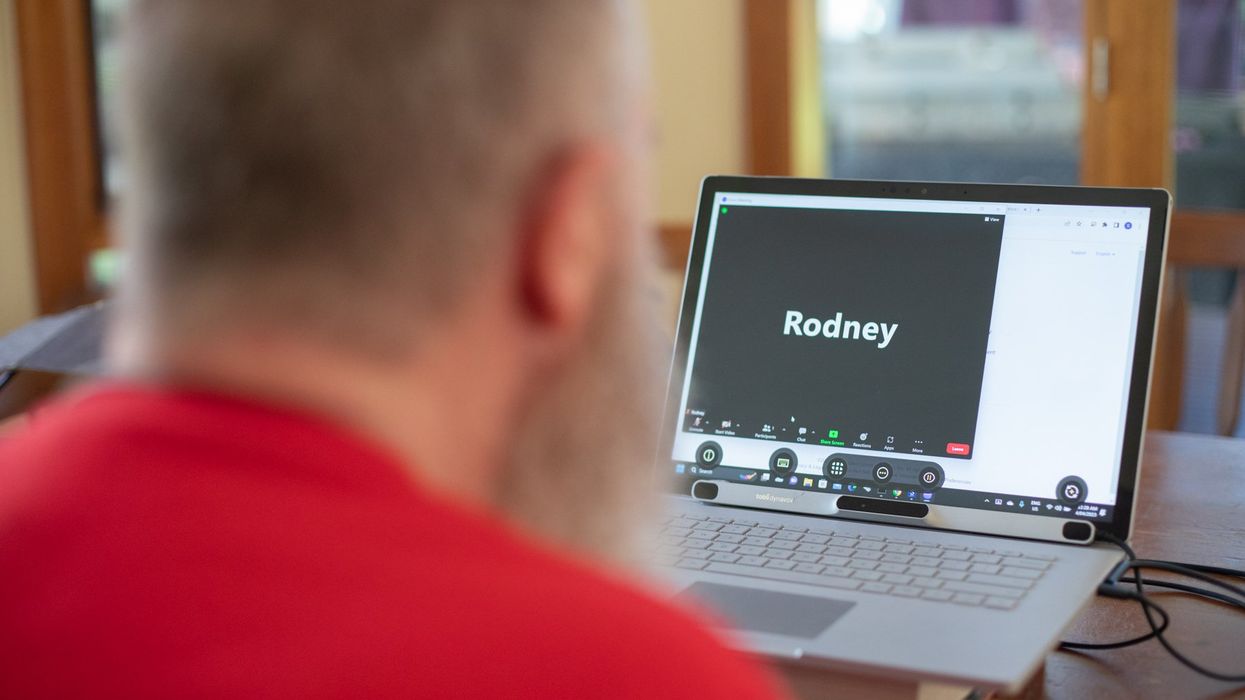Would You Want to Know a Decade Early If You Were Getting Alzheimer's?

The author pictured with her husband Dallas, who has Alzheimer's.
Editor's Note: A team of researchers in Italy recently used artificial intelligence and machine learning to diagnose Alzheimer's disease on a brain scan an entire decade before symptoms show up in the patient. While some people argue that early detection is critical, others believe the knowledge would do more harm than good. LeapsMag invited contributors with opposite opinions to share their perspectives.
I first realized something was wrong with my dad when I came home for Thanksgiving 20 years ago.
I hadn't seen my family for more than a year after moving from New York to California. My father was meticulous, a multi-shower a day man, a regular Beau Brummell. He was never officially diagnosed with dementia, but it was easy to figure out after he stopped leaving the house, stopped reading, stopped being himself. My mother knew, but she never sought help. After his illness showed itself, I asked her if she considered a nursing home. "Never," she told me. "I can take care of him." And she did.
She gave herself a break once to visit me, and it was the first time she traveled separately from him since they eloped at seventeen. My brother watched my father, and it was not smooth. Dad was angry, hallucinating, and demanding his gun, which had been disposed of long ago. While Mom was visiting me in California, we played some board games. One demanded honest answers. The card read, What are you most afraid of? "Dementia," she said.
My father never saw this coming, none of us did.
Dementia ran on my mother's side. Her mother, my Nana, was senile, the popular diagnosis for older folks back then. My grandfather tried his hardest to take care of her, but she kept escaping their tidy 6th floor apartment to run away. My mother would go over every day to take care of them, but once my grandfather became ill, she took her mother into our apartment. She had two small children, Nana, and her husband in a two-bedroom flat. Nana talked to people under plates, wore tissues on her head, and tried to escape. We were on the first floor, so she could run into traffic if all eyes weren't on her. Soon, it was too much, even for my Wonder Woman mom. Nana was placed in a nursing home and died soon after.
My mother dropped dead on a NYC sidewalk two years after my father started to deteriorate. She was probably going to the store to buy milk and cigarettes. A kind stranger called 911, and a cop came to my parent's door soon after to tell my dad the news. My father cried for death, raged and ranted, then calmed down enough to come back as the dad we remembered for the week of mourning. He even ordered a Manhattan at dinner. His death came exactly a week and an hour after my mother's. He died of a broken heart. My husband cried with all his body after we left the cemetery, weeping, "Poor Buck. Poor Buck." I never saw him cry before.
Now, 18 years later, I sit here with my husband, 59 years old, as he suffers from the same hideous disease.
He is talking to someone I can't see, even laughing with him. He holds a Ph.D. in literature, taught college, had a single handicap golf game, and ate well. We never saw this coming. One day he went to type and jumbled letters came on the screen. He would show up late or early for his classes, wondering what was wrong with the students. He started running red lights. He was graciously counseled to retire, and he did, at 55. His doctor told him it was depression. The second opinion agreed. He was told to do nothing for a year, and he did. He played golf a bit, then one day he couldn't speak or think clearly. I came home from work to find him roaming the neighborhood, eyes ablaze, muttering to himself. I went on family leave. Many tests later we got the working diagnosis, but it meant nothing to him. He never reacted to the words Primary Progressive Aphasia or dementia. I was glad. If he was lucid, I knew what he would talk about doing. He told me after my dad's death that he did not want that life for himself.
I worry I may get it, too. It almost seems inescapable. Dementia has no cure, and the treatments for the symptoms are hit and miss. I thought about getting the full flight of predictive tests, but I know myself, and I scare myself into bracing for the worst. Others scare me, too, when I read their online statements about ending their lives if they learn they have it: I told my children to take me to a state where assisted suicide is legal; it's easy to overdose; I don't want to be a burden on my children. These are caregivers on social media forums. They live with the terror, eyes wide open. We have no children, but who would I burden? My sisters? My brother? Do I stay or do I go? This disease invites pandemonium. Assisted murder-suicides with caregiver spouses of those with dementia don't merit headlines, but their stories are on the sidebars. No thanks. I work on God's timeline.
There are no survivors – yet.
A diagnosis today would paralyze me and create melancholy for all who know me. I would second guess everything, I would read everything, I would cry, I would hardly live. I would be tempted to pick up that first drink after 20 plus years sober. I would even think about ending my life. It would be difficult not to consider. As a high school English teacher, I talk about suicide when I teach Hamlet. I tell the students suicide is a permanent solution to a temporary problem. Dementia isn't temporary. There are no survivors – yet.
I often think what my relatives would have done with an advance diagnosis. My grandmother was a classic worrier. She would have been beyond distraught. My father might have found that gun. My husband would have taken the right number of pills.
An advance diagnosis would paralyze me.
I appreciate the arguments for early diagnosis. Some people are made of sterner stuff. They have the mindset I lack. I admire so many who are contributing to the current conversation about dementia and are active advocates for a cure. They have found a purpose in their fate.
I don't need a test to get my ducks in a row. Loving those with dementia has prompted me to be prepared. I have a different type of bucket list: reset my priorities, slow down, be present, educate others, and make my legal plans. If and when it happens, there will be time for toast and tea and a walk along the shore. There will be time to plan for the inevitable and unenviable end. I am morbid enough to know I will recognize the purple elephant in the room. I don't want the shock and awe now. I can wait. My sisters agree. We will keep our elbows out.
Editor's Note: Consider the other side of the argument here.
New implants let paraplegics surf the web and play computer games
Rodney Gorham, an Australian living with ALS, has reconnected with the world, thanks to a brain-machine interface called the Stentrode.
When I greeted Rodney Gorham, age 63, in an online chat session, he replied within seconds: “My pleasure.”
“Are you moving parts of your body as you type?” I asked.
This time, his response came about five minutes later: “I position the cursor with the eye tracking and select the same with moving my ankles.” Gorham, a former sales representative from Melbourne, Australia, living with amyotrophic lateral sclerosis, or ALS, a rare form of Lou Gehrig’s disease that impairs the brain’s nerve cells and the spinal cord, limiting the ability to move. ALS essentially “locks” a person inside their own body. Gorham is conversing with me by typing with his mind only–no fingers in between his brain and his computer.
The brain-computer interface enabling this feat is called the Stentrode. It's the brainchild of Synchron, a company backed by Amazon’s Jeff Bezos and Microsoft cofounder Bill Gates. After Gorham’s neurologist recommended that he try it, he became one of the first volunteers to have an 8mm stent, laced with small electrodes, implanted into his jugular vein and guided by a surgeon into a blood vessel near the part of his brain that controls movement.
After arriving at their destination, these tiny sensors can detect neural activity. They relay these messages through a small receiver implanted under the skin to a computer, which then translates the information into words. This minimally invasive surgery takes a day and is painless, according to Gorham. Recovery time is typically short, about two days.
When a paralyzed patient thinks about trying to move their arms or legs, the motor cortex will fire patterns that are specific to the patient’s thoughts.
When a paralyzed patient such as Gorham thinks about trying to move their arms or legs, the motor cortex will fire patterns that are specific to the patient’s thoughts. This pattern is detected by the Stentrode and relayed to a computer that learns to associate this pattern with the patient’s physical movements. The computer recognizes thoughts about kicking, making a fist and other movements as signals for clicking a mouse or pushing certain letters on a keyboard. An additional eye-tracking device controls the movement of the computer cursor.
The process works on a letter by letter basis. That’s why longer and more nuanced responses often involve some trial and error. “I have been using this for about two years, and I enjoy the sessions,” Gorham typed during our chat session. Zafar Faraz, field clinical engineer at Synchron, sat next to Gorham, providing help when required. Gorham had suffered without internet access, but now he looks forward to surfing the web and playing video games.

Gorham, age 63, has been enjoying Stentrode sessions for about two years.
Rodeny Dekker
The BCI revolution
In the summer of 2021, Synchron became the first company to receive the FDA’s Investigational Device Exemption, which allows research trials on the Stentrode in human patients. This past summer, the company, together with scientists from Icahn School of Medicine at Mount Sinai and the Neurology and Neurosurgery Department at Utrecht University, published a paper offering a framework for how to develop BCIs for patients with severe paralysis – those who can't use their upper limbs to type or use digital devices.
Three months ago, Synchron announced the enrollment of six patients in a study called COMMAND based in the U.S. The company will seek approval next year from the FDA to make the Stentrode available for sale commercially. Meanwhile, other companies are making progress in the field of BCIs. In August, Neuralink announced a $280 million financing round, the biggest fundraiser yet in the field. Last December, Synchron announced a $75 million financing round. “One thing I can promise you, in five years from now, we’re not going to be where we are today. We're going to be in a very different place,” says Elad I. Levy, professor of neurosurgery and radiology at State University of New York in Buffalo.
The risk of hacking exists, always. Cybercriminals, for example, might steal sensitive personal data for financial reasons, blackmailing, or to spread malware to other connected devices while extremist groups could potentially hack BCIs to manipulate individuals into supporting their causes or carrying out actions on their behalf.
“The prospect of bestowing individuals with paralysis a renewed avenue for communication and motor functionality is a step forward in neurotech,” says Hayley Nelson, a neuroscientist and founder of The Academy of Cognitive and Behavioral Neuroscience. “It is an exciting breakthrough in a world of devastating, scary diseases,” says Neil McArthur, a professor of philosophy and director of the Centre for Professional and Applied Ethics at the University of Manitoba. “To connect with the world when you are trapped inside your body is incredible.”
While the benefits for the paraplegic community are promising, the Stentrode’s long-term effectiveness and overall impact needs more research on safety. “Potential risks like inflammation, damage to neural tissue, or unexpected shifts in synaptic transmission due to the implant warrant thorough exploration,” Nelson says.
There are also concens about data privacy concerns and the policies of companies to safeguard information processed through BCIs. “Often, Big Tech is ahead of the regulators because the latter didn’t envisage such a turn of events...and companies take advantage of the lack of legal framework to push forward,” McArthur says. Hacking is another risk. Cybercriminals could steal sensitive personal data for financial reasons, blackmailing, or to spread malware to other connected devices. Extremist groups could potentially hack BCIs to manipulate individuals into supporting their causes or carrying out actions on their behalf.
“We have to protect patient identity, patient safety and patient integrity,” Levy says. “In the same way that we protect our phones or computers from hackers, we have to stay ahead with anti-hacking software.” Even so, Levy thinks the anticipated benefits for the quadriplegic community outweigh the potential risks. “We are on the precipice of an amazing technology. In the future, we would be able to connect patients to peripheral devices that enhance their quality of life.”
In the near future, the Stentrode could enable patients to use the Stentrode to activate their wheelchairs, iPods or voice modulators. Synchron's focus is on using its BCI to help patients with significant mobility restrictions—not to enhance the lives of healthy people without any illnesses. Levy says we are not prepared for the implications of endowing people with superpowers.
I wondered what Gorham thought about that. “Pardon my question, but do you feel like you have sort of transcended human nature, being the first in a big line of cybernetic people doing marvelous things with their mind only?” was my last question to Gorham.
A slight smile formed on his lips. In less than a minute, he typed: “I do a little.”
Leading XPRIZE Healthspan and Beating Negativity with Dr. Peter Diamandis
XPRIZE founder and chairman Peter Diamandis launches XPRIZE Healthspan at an event on November 29.
A new competition by the XPRIZE Foundation is offering $101 million to researchers who discover therapies that give a boost to people aged 65-80 so their bodies perform more like when they were middle-aged.
For today’s podcast episode, I talked with Dr. Peter Diamandis, XPRIZE’s founder and executive chairman. Under Peter’s leadership, XPRIZE has launched 27 previous competitions with over $300 million in prize purses. The latest contest aims to enhance healthspan, or the period of life when older people can play with their grandkids without any restriction, disability or disease. Such breakthroughs could help prevent chronic diseases that are closely linked to aging. These illnesses are costly to manage and threaten to overwhelm the healthcare system, as the number of Americans over age 65 is rising fast.
In this competition, called XPRIZE Healthspan, multiple awards are available, depending on what’s achieved, with support from the nonprofit Hevolution Foundation and Chip Wilson, the founder of Lululemon and nonprofit SOLVE FSHD. The biggest prize, $81 million, is for improvements in cognition, muscle and immunity by 20 years. An improvement of 15 years will net $71 million, and 10 years will net $61 million.
In our conversation for this episode, Peter talks about his plans for XPRIZE Healthspan and why exponential technologies make the current era - even with all of its challenges - the most exciting time in human history. We discuss the best mental outlook that supports a person in becoming truly innovative, as well as the downsides of too much risk aversion. We talk about how to overcome the negativity bias in ourselves and in mainstream media, how Peter has shifted his own mindset to become more positive over the years, how to inspire a culture of innovation, Peter’s personal recommendations for lifestyle strategies to live longer and healthier, the innovations we can expect in various fields by 2030, the future of education and the importance of democratizing tech and innovation.
In addition to Peter’s pioneering leadership of XPRIZE, he is also the Executive Founder of Singularity University. In 2014, he was named by Fortune as one of the “World’s 50 Greatest Leaders.” As an entrepreneur, he’s started over 25 companies in the areas of health-tech, space, venture capital and education. He’s Co-founder and Vice-Chairman of two public companies, Celularity and Vaxxinity, plus being Co-founder & Chairman of Fountain Life, a fully-integrated platform delivering predictive, preventative, personalized and data-driven health. He also serves as Co-founder of BOLD Capital Partners, a venture fund with a half-billion dollars under management being invested in exponential technologies and longevity companies. Peter is a New York Times Bestselling author of four books, noted during our conversation and in the show notes of this episode. He has degrees in molecular genetics and aerospace engineering from MIT and holds an M.D. from Harvard Medical School.
Show links
- Peter Diamandis bio
- New XPRIZE Healthspan
- Peter Diamandis books
- 27 XPRIZE competitions and counting
- Life Force by Peter Diamandis and Tony Robbins
- Peter Diamandis Twitter
- Longevity Insider newsletter – AI identifies the news
- Peter Diamandis Longevity Handbook
- Hevolution funding for longevity

XPRIZE Founder Peter Diamandis speaks with Mehmoud Khan, CEO of Hevolution Foundation, at the launch of XPRIZE Healthspan.
Hevolution Foundation

